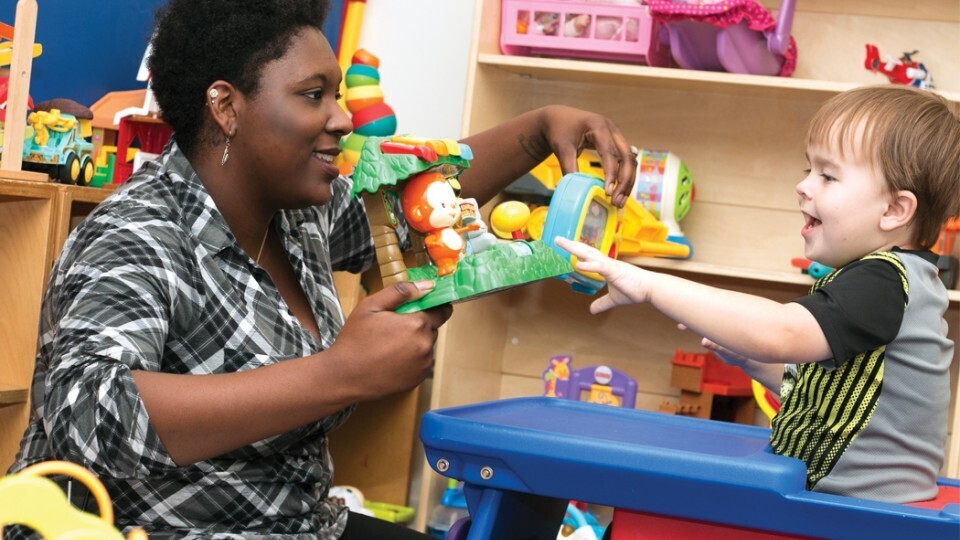Tiffany Lee, April 21, 2021
Nebraska researchers stepping up to help people, families affected by autism
April is Autism Acceptance Month, a national effort led by the Autism Society of America aimed at increasing inclusivity in everyday life, promoting acceptance and providing information and resources to boost awareness of autism. Autism is a lifelong developmental disability that impacts a person’s social skills, communication, relationships and self-regulation. In line with national trends, Nebraska’s rate of autism diagnosis has been on the rise. In 2002, our state had about 200 students with an educational identification of autism. Today, that number stands at just under 5,000, making the need for acceptance increasingly important. To highlight how the University of Nebraska-Lincoln is helping in that effort, we’ve put the spotlight on five researchers and practitioners whose work helps to maximize the talents of people with autism, ensure the best possible education and resources for them, and support their families.

Tapping into the power of green space
With funding from the U.S. Forest Service, Julia Torquati studies how natural environments and the presence of green space can help mitigate conduct problems in children with autism, opening the door for them to develop deeper friendships and learn more effectively at school.
Along with Husker researcher Anne Schutte and colleagues at Georgia State University, Torquati is studying whether schools can harness the power of trees and vegetation to foster improvements in attention, inhibitory control and spatial working memory in children with autism. The team is currently analyzing data to determine if children with autism who went on a nature walk show improved cognitive functioning afterward when compared with children who walked in a more urban area.
They’ve also published a separate paper indicating that areas with greater tree canopy have a potentially ameliorative effect on the behavior of children with autism, even when other factors, like the socioeconomic status of a neighborhood, are statistically controlled.
This suggests that schools can support students with autism by building more green features into their play yards.
“It doesn’t have to be huge,” Torquati said. “For a traditional school yard that features a soccer field, you could create trees, shrubs and spaces that children can be in and restore themselves. Even a green view out a window can be helpful and serve as a micro-break with a calming effect.”
The overarching goal isn’t just to improve behavior for the sake of compliance, but to help children self-regulate and minimize disruptive behaviors that impede learning and socializing.
“If you have lower levels of behavior problems, you’re better able to learn,” she said. “And you’re better able to make friends, which is so critical to well-being.”

Training school psychologists to work with toddlers
A Nebraska research team recently completed a U.S. Department of Education-funded project that trained 18 pre-service school psychologists in delivering applied behavior analysis, or ABA, services to toddlers with autism spectrum disorder. Supported by $1.25 million in grant funding, the program enabled trainees to gain skills in assessment, diagnosis and behavioral treatment, parent advocacy and interprofessional collaboration, all of which are essential in providing young children with autism timely and comprehensive care.
“This project will directly help children and families with ASD because it has increased the number of school psychologists currently working in Nebraska who are educated and clinically trained in these services, particularly for toddlers and preschoolers,” said Ed Daly, professor of educational psychology.
The newly trained school psychologists will pass their knowledge to other school personnel, ensuring that evidence-based, ecologically sound assessments and behavioral treatments are used in early education and elementary school settings.
The Nebraska research team also includes Terri Mathews, William Higgins and Kathryn Menousek of the University of Nebraska Medical Center; Sue Sheridan of UNL; and former Husker researcher Gina Kunz.

Developing evidence-based practices for special education
Susan Loveall focuses her research on the reading, learning and language skills of both typically developing children and individuals with intellectual and developmental disabilities, including autism.
She’s using funding from the National Institutes of Health and the university’s Research Council to better understand the reading and writing skills of students with intellectual and developmental disabilities. A major problem in special education reading instruction is that teachers don’t have a clear picture of what works. To begin to remedy that, Loveall is teaming up with Derek Rodgers on Project Pathways, which focuses on students ages 13 to 21.
“We know very little about what they struggle with or things they do pretty well with,” she said. “We’re trying to develop a detailed reading and writing profile of students with intellectual and developmental disabilities so we can identify specific subskills to target in intervention.”
The pair is also launching a national survey of special education teachers to determine what practices are currently being used in the classroom, and the extent to which teachers think the reading and writing skills of students with intellectual and developmental disabilities are malleable.
Loveall’s research is inspired by a desire to see students with intellectual and developmental disabilities achieve their goals across their lifespan, she said. Right now, when these students approach graduation, the focus often shifts away from academic skills like reading and writing toward functional life skills.
“We feel that is a false dichotomy,” she said. “Adaptive skills shouldn’t be totally separate from reading and writing, because reading and writing help facilitate independence.”

Annette Wragge is the state coordinator for the Nebraska Autism Spectrum Disorders Network, a program funded by the Nebraska Department of Education aimed at enhancing the capacity of Nebraska’s schools and families to support children with autism. Wragge said the network has two primary areas of work: training for educators and families, and collaboration with schools that need assistance.
“School districts can say, ‘We need help,’ and we’ll go in and observe and see where we can contribute,” Wragge said. “It might be with identifying students with autism, program planning, teaching skills or managing behavior.”
The network also offers a wide range of training opportunities, including 75 on-demand webinars, more than 50 in-person trainings per year, a 40-hour behavior class and an annual state conference. Most of the sessions are free of charge to enhance accessibility.
Wragge is housed in Nebraska’s Department of Special Education and Communication Disorders, which enables her to bring the knowledge she gains on the ground to the university community. She often guest lectures to speech pathology students and serves on research advisory committees as requested.
Having worked with the network since its inception in 2002, Wragge has watched as an increasing number of students have received an education identification of autism in Nebraska. When she started, there were about 200 children with that classification; today, that number stands at just under 5,000. This trend makes acceptance of people with autism all the more crucial.
“I love the lessons we learn from families and self-advocates about the movement toward acceptance,” she said. “We want doctors and providers to identify autism earlier, but we don’t want to change everything about who people are. I love that shift.”

Boosting writing skills for real-world success
Derek Rodgers has expertise in developing classroom-based practices to improve writing skills at the paragraph level for students with autism and other developmental disabilities.
At first glance, skills like punctuation, grammar and syntax may not seem like a priority for students with disabilities. But Rodgers sees them as key to boosting success in the real world: Students need writing skills to use social media to stay connected, apply for jobs or communicate over email.
“We want to make sure their writing is not so incoherent that it serves as a barrier to whatever they’re trying to do,” Rodgers said. “If we can improve their writing, we can improve their lives.”
Right now, Rodgers said, there’s a dearth of evidence-based practices to deploy in special education classrooms, in part because writing instruction – even for neurotypical students – often is not prioritized. To fill that gap, Rodgers is collaborating with Susan Loveall on Project Pathways, which maps out the strengths, weaknesses and overall reading and writing abilities of students with certain kinds of disabilities, including autism. This work, focused on students ages 13 to 21, is a stepping stone to larger projects that produce classroom interventions.
Rodgers is also interested in boosting the writing skills of students with autism who don’t have an intellectual disability. These students sometimes struggle with “theory of mind” – the ability to infer others’ mental states.
“They may struggle with what the audience knows and doesn’t know, or have difficulty putting themselves into the role of their reader,” Rodgers said.






